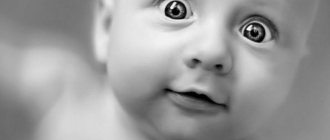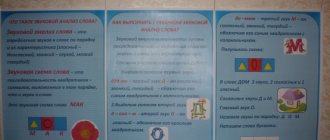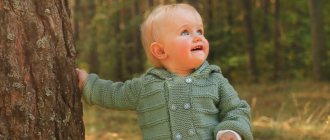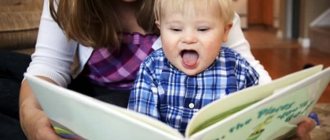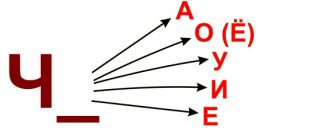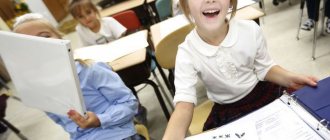Methods for examining the syllable structure of a word
Elena Kozlova
Methods for examining the syllable structure of a word
1. Methodology for examining the syllabic structure of words , proposed by Z. E. Agranovich.
Methodology for examining children 3 years old . Children are asked to reproduce, following the teacher-speech therapist words consisting of 2 syllables , for example, (cotton wool, willow, owl, and so on, of 3 syllables (cabin, car, ducklings, and so on)
1
syllable , for example, (poppy, juice, smoke, and so on)
.
In this case, the total number of correctly reproduced syllables .
Methodology for examining children 4-5 years old . Children are offered various types of words : simple - from open syllables without a combination of consonants; more complex - from 4-5 syllables with a combination of consonants at the beginning, middle, end of the word . Speech material can be as follows: snow, cabbage, roof, cat, bridge, button, birdhouse, curdled milk, medicine, tomatoes, draft, TV, frying pan , whistle, policeman, aquarium, hairdresser, construction.
The types of work should vary:
- name the subject pictures;
- repeat the words after the speech therapist ;
— answer questions (Where is hair cut)
.
After 5 years, children are given the task of repeating after the speech therapist sentences with a large concentration of complex words , for example:
The plumber was fixing the water pipe.
A policeman regulates street traffic.
Multi-colored fish swim in the aquarium.
Builders are working on the construction of a high-rise building.
Hair being cut in a barbershop.
In addition, children are encouraged to independently make sentences based on the plot pictures.
2. Methodology for examining the state of the syllabic structure of words , authors G. V. Babina and N. Yu. Safonkina.
The survey methodology includes four series of tasks. The first series consists of a set of tasks aimed at identifying the features of the syllabic design of words of varying degrees of complexity (naming presented pictures, reflected pronunciation of words , completing phrases and sentences ).
The second series includes sets of tasks that allow us to determine the peculiarities of perception of the rhythmic and structural characteristics of a word (based on the auditory presentation of syllables , words and quasi-words ).
The third - includes sets of tasks aimed at identifying the state of complex parameters of motor acts - dynamic and rhythmic (when performing serial movements of the organs of articulation, arms and legs)
.
The fourth series consists of a set of tasks aimed at studying the features of optical-spatial orientation (somato-spatial and orientation in three-dimensional and two-dimensional space.
3. Methodology according to classification A. K. Markova
During the examination , the child is asked to pronounce 14 types of words with different syllable structures according to classification A. K. Markova. The types of tasks are different: answer questions in whole sentences, repeat phrases with polysyllabic words , name object pictures, repeat words after a speech therapist . All tasks are given in a playful way using pictures and toys.
Traditionally, it is customary to examine the syllable structure , starting from the first grade to the fourteenth, gradually complicating the words .
Dictionary:
Grade 14 – four-syllable words with consonant clusters
(aquarium, strawberries, tape recorder, excavator)
.
Grade 13 – four-syllable words consisting of open syllables (button, piano)
.
Grade 12 – two-syllable words with two consonant clusters (nest, chicks, beets)
.
11th grade – monosyllabic words with consonant clusters at the beginning or end of the word (mushroom, gnome, key, elephant)
.
Grade 10 – three-syllable words with two consonant clusters (matryoshka, light bulb, firecracker)
.
9th grade – three-syllable words with a combination of consonants and a closed syllable (helicopter, grasshopper, orange)
.
8th grade – three-syllable words with a combination of consonants (radish, cabbage, apple)
.
Grade 7 – three-syllable words with a closed syllable (tomato, cucumber, drum)
.
Grade 6 – two-syllable words with a closed syllable and a cluster of consonants in the middle of the word (album, notebook, garlic)
.
Grade 5 – two-syllable words with a cluster of consonants in the middle of the word (pine trees, branches, letters)
.
Grade 4 – two-syllable words consisting of one open and one closed syllable (rooster, broom, banana)
.
Grade 3 – monosyllabic words consisting of a closed syllable (poppy, forest, cat)
.
Grade 2 – three-syllable words consisting of open syllables (rooster, broom, banana)
.
1st grade – two-syllable words consisting of open syllables (poppy, forest, cat)
.
Article:
Task 1. Pronouncing monosyllabic words without clusters of consonants.
Speech and picture material: house, smoke, poppy, cat, bull, whale. Task 2. Pronouncing two-syllable words without clusters of consonants. Speech and picture material:
a) words like SGSG - fly, fox, water, cotton wool, cats, notes;
b) words like SGSGS - rooster, banana, sofa, hamster, carriage, broom.
Task 3. Pronouncing monosyllabic words with clusters of consonants. Speech and picture material:
a) words with clusters of consonant sounds at the beginning of the word - gnome, bread, chair, pancake, grandson, maple;
b) words with clusters of consonant sounds at the end of the word - bow, tank, umbrella, bandage, screw, leaf.
Task 4. Pronouncing two-syllable words with clusters of consonants. Speech and picture material:
a) words with clusters of consonant sounds at the junction of syllables - duck, bank, bows, jacket, slippers, bear;
b) words with clusters of consonant sounds at the beginning of the word - signs, gnomes, elephants, cabinets, tables, stupa.
Task 5. Pronouncing three-syllable words without clusters of consonants. Speech and picture material:
a) words like SGSSGSG - Panama, cubes, foxes, dog, car, shovel;
b) words like SGSGSGSGS - kitten, tomato, bun, telephone, hippopotamus, drum.
Task 6. Pronouncing three-syllable words with clusters of consonants. Speech and picture material:
bus, orange, grapes, candy, pencil, machine gun;
gun, chicken, apple, alarm clock, strawberry, jump rope.
Task 7. Pronouncing polysyllabic words.
Speech and picture material:
a) words without combinations of consonants - Pinocchio, turtle, airplanes, corn, caterpillar, pasta; buttons, pyramid, carousels, drums, TV, bicycle;
b) words with clusters of consonant sounds - towel, traffic lights, frying pan, astronauts, teacher, teacher.
Complex B
Tasks for reflected (if necessary - slow) and conjugate pronunciation of words, including complex in structure and low-frequency ones. They are proposed with the aim of establishing the nature of distortions in this version of the use of words, ascertaining the influence of the standard of pronunciation of a lexical unit on the quality of pronunciation by children. The leading technique is repetition of words after the speech therapist (or together with the speech therapist) with visual support on subject or plot pictures. Instructions: “Look, listen, repeat,” “Repeat with me.”
Task 1 - Reflected (conjugate) pronunciation of monosyllabic words without clusters of consonants.
Speech and picture material: moss, fur, fluff, tank, Bim, Bom.
Task 2. Reflected (conjugate) pronunciation of two-syllable words without clusters of consonants.
Speech and picture material:
a) words like GHA and SGSG - willow, bots, children, coffee, whales, houses;
b) words like SGSGS - wreath, hammock, lawn, smoke, wild boar, salad.
Task 3. Reflected (conjugate) pronunciation of monosyllabic words with clusters of consonants.
Speech and picture material: two, courtyard, sheaf, elevator, bridge, bush.
Task 4. Reflected (conjugate) pronunciation of two-syllable words with clusters of consonants.
Speech and picture material:
a) words with clusters of consonant sounds at the junction of syllables - sheep, pumpkin, thread, bunny, bowl, turkey; cactus, fountain, jug, magnet, soldier, chestnut;
b) words with clusters of consonant sounds at the beginning and middle of the word - cranberry, fruit, star, nest, button, satellite;
c) words with several clusters of consonants - envelope, prospectus, penguin, Moscow (Kremlin), camel, actress.
Task 5. Reflected (conjugate) pronunciation of three-syllable words without clusters of consonants.
Speech and picture material:
a) words like SGSSGSG - road, crow, magpie, gate, Galina, raspberry;
b) words like SGSGSGSGS - sparrow, cockerel, nightingale, cornflower, ceiling, spikelet.
Task 6. Reflected (conjugate) pronunciation of three-syllable words with clusters of consonants.
Speech and picture material:
a) words with one set of consonants - room, dumbbells, pharmacy, octopus, hunter, monument;
b) words with two clusters of consonants - Dunno, apartment, carnation, food, football player, satellites.
Task 7. Reflected (conjugate) pronunciation of polysyllabic words.
Speech and picture material:
a) words without clusters of consonants - divers, suitcases, rhinoceroses, scooters, hippopotamuses, telephones; captains, cockroaches, lizard, shell, cobweb, piano;
b) words with clusters of consonant sounds - switch, refrigerator, Snow Maiden, chess players, tour guide, cyclist.
Complex B
Tasks to identify the features of multiple reflected reproduction of words. They are offered with the aim of clarifying the possibilities of maintaining the action program during the pronunciation process.
Task 1. Multiple repetition of a word based on the presented sample. Instructions: “Listen, repeat three or four times.”
Example speech material: banana, bread, bear, magnet, penguin, monument, sparrow, cockerel, orange, hammer, astronaut, lizard, teacher, etc.
Task 2. Repeating a word multiple times without relying on a standard.
Instructions: “Look, name, repeat several times.”
Approximate speech and picture material: lemon, hammock, gnome, screw, sheep, cactus, star, satellite, Panama hat, raspberry, airplane, spikelet, pharmacy, football player, Pinocchio, caterpillar, teacher, etc.
Note. Picture material from previous complexes is used.
Complex G
Tasks to identify features of the state of the syllabic composition of a word in a minimal context. They are offered to clarify the possibilities of using words of varying degrees of complexity as part of phrases and sentences.
Task 1. Completing phrases and sentences (substituting the desired word) based on the picture.
Instructions: “I will start speaking, and you will finish. A picture will help you."
Speech and picture material:
a) adding a word without changing its grammatical form: “Yellow ... (lemon); Katina... (Panama); sailing... (steamboat); prickly... (cactus); brave... (soldier); long-nosed... (Pinocchio)";
b) adding a word with a change in its grammatical form: “I draw... (caterpillar); we fed... (Bima); we will fly on ... (plane); I will put the letter in ... (envelope); I want to be... (astronaut); I dream of... (a bicycle)."
If necessary, the speech therapist uses a pointing gesture to the picture and/or a question (for example: “We will fly... on what?”).
Note. The picture material is given for the words taken in brackets.
Task 2. Reflected pronunciation of constructions including words of varying structural complexity.
Instructions: “Look, listen, repeat.”
Speech and picture material:
a) Bim at home; Bim is sleeping; Bim is resting; shaggy Bim; Bim sweeps; Bim is hunting;
b) Bim is driving a truck; Bim plays the piano; Bim feeds the chicken; Bim saw a penguin; Bim buys groceries; Bim works as a policeman.
Complex D
Tasks to identify the features of repeated reproduction of phrases and sentences. They are offered with the aim of finding out the possibilities of maintaining the program of action in the process of speaking.
Task 1. Repeated (3-4 times) reproduction of the design with constant presentation of the sample.
Instructions: “Listen, repeat”; “Listen again, repeat.” Etc.
Speech and picture material: a bunny jumps; tankers are driving; indoor flower; the gnome eats bread; Galina eats raspberries; the gardener waters the rose hips.
Task 2. Repeated (3-4 times) reproduction of the design without constant presentation of the sample.
Instructions: “Listen, repeat several times.”
Speech and picture material: a car is driving; colored paper; sweet bananas; signs at the intersection; satellites in space; There is a fox under the bush.
It is recommended to analyze the results of the first series of tasks taking into account the following criteria:
— the level of complexity of the syllabic structure of a word that can be pronounced;
— quantity and nature of distortions;
— the state of the rhythmic pattern of words during playback (chanting, presence of stress);
— tempo characteristics of word reproduction (speed, pausing);
— presence/absence of a certain type of distortion;
— strategy for analyzing the structure of a lexical unit;
- control of correctness when pronouncing a word.
Sound pronunciation examination protocol
Sound| Optical stimulus | Speech reaction to optical stimulus | Speech response to an acoustic stimulus | Using sound in your own speech | Pronunciation of sound | The nature of the sound pronunciation disorder | Notes | ||||
| In syllables | Isolated | Absence | Distortion | Replacement | Mixing | |||||
| 1 | 2 | 3 | 4 | 5 | 6 | 7 | 8 | 9 | 10 | |
| Y | ||||||||||
| A | ||||||||||
| U | ||||||||||
| ABOUT | ||||||||||
| AND | ||||||||||
| WITH | ||||||||||
| 3 | ||||||||||
| P | ||||||||||
| ILL | ||||||||||
| and | ||||||||||
| h | ||||||||||
| w | ||||||||||
| L | ||||||||||
| R | ||||||||||
| B_ | ||||||||||
| P | ||||||||||
| D | ||||||||||
| G |
| To |
| X |
| m |
| n |
| V |
| f |
| T |
| th |
| AI TO HER |
| EB YA |
conclusions
Appendix 3
| № | Characteristics of speech material | Speech material | Reaction to optical stimulus | Reaction to acoustic stimulus | Reproduction of syllables |
| 1 | Monosyllabic words with a closed syllable | ||||
| 2 | Monosyllabic words with consonant clusters | ||||
| 3 | Two-syllable words with 2 straight open syllables | ||||
| 4 | Two-syllable words with 1 closed syllable | ||||
| 5 | Two-syllable words with a cluster of consonants in the middle of the word | ||||
| 6 | Two-syllable words with a consonant cluster at the beginning and a closed syllable at the end of the word | ||||
| 7 | Two-syllable words with 2 consonant clusters | ||||
| 8 | Three-syllable words made from open syllables | ||||
| 9 | Three-syllable words with a closed syllable at the end of the word | ||||
| 10 | Three-syllable words with consonant clusters | ||||
| 11 | Three-syllable words with a consonant cluster and a closed syllable | ||||
| 12 | Four-syllable words with open syllables | ||||
| 13 | Polysyllabic words with complex structure | ||||
| 14 | The proposals include: | ||||
The structure of a speech therapy lesson at the stage of sound production Topic:
Target:
Tasks:
Educational:
Corrective:
Educational:
Equipment:
mirrors, probes, spatulas, profile and diagram of sound articulation, syllable tracks and tables, subject and plot pictures, etc. Progress of
the lesson:
- 1. Organizational moment.
- 2. Articulation exercises: a) general articulation exercises;
- b) special articulation exercises;
- c) exercises to develop the strength of the voice and exhalation.
- 3. Announcing the topic of the lesson.
- 4. Sound production (by imitation, from reference sounds, from articulatory gymnastics, with mechanical assistance).
- 5. Analysis of articulation according to plan (using a diagram or profile of sound articulation): position of lips, teeth, tongue (tip, back, root); participation of vocal folds; the nature of the exhaled air stream.
- 6. Consolidation of isolated sound: conjugate and individual pronunciation, onomatopoeia games.
- 7. Development of phonemic hearing:
- b) from a sentence;
- c) from words;
- d) from syllables;
- e) from a series of isolated sounds, distant in articulatory and acoustic similarity.
- 8. Consolidation of sound in syllables.
- 9. Consolidating sounds in words.
- 10. Fixing the sound in a sentence.
- 11. Homework.
- 12. Lesson summary:
- b) analysis of the main provisions of the articulation of the sound being studied;
- c) final pronunciation (conjugate, individual).
- 13. Assessment of the child’s activity in class (carried out with a positive psychotherapeutic focus).
- 1. Organizational moment.
- 2. Articulation gymnastics (special articulation exercises).
- 3. Announcing the topic of the lesson.
- 4. Pronunciation of an isolated sound (conjugate, group, chain, individual).
- 5. Analysis of articulation according to plan.
- 6. Characteristics of sound (vowel - consonant, voiceless - voiced, hard - soft, etc.).
- 7. Connection of sound with letter.
- 8. Development of phonemic hearing.
- 9. Consolidation of sound in syllables. Sound analysis and synthesis of syllables, their graphic recording.
- 10. Consolidating sounds in words. Sound-syllable analysis of words with graphic notation.
- 11. Fixing the sound in a sentence. Graphic recording of a proposal.
- 12. Fixing sound in text.
- 13. Homework.
- 14. Summary of the lesson.
- 15. Assessment of children's activities in class.
- 1. Organizational moment.
- 2. Articulation gymnastics. Only basic exercises are planned, modeling the main articulatory movements for both sounds.
- 3. Announcing the topic of the lesson.
- 4. Pronunciation of isolated sounds (conjugate, individual, using onomatopoeia).
- 5. Analysis of the articulation of sounds according to plan, highlighting common and different points of articulation.
- 6. Characteristics of sounds.
- 7. Connection of sounds and letters.
- 8. Development of phonemic hearing. Differentiation of sounds in isolated form.
- 9. Differentiation of sounds in syllables. Reading syllables from tables or repeating with a speech therapist. Graphic analysis of syllables.
- 10. Differentiation of sounds in words. Working with paronymous words, sound-syllable analysis of words.
- 11. Differentiation of sounds in a sentence. Analysis of a sentence with graphical recording and selection of words containing smsshi^vasmys sounds, and then selection of these sounds from the words.
- 12. Differentiation of sounds in the text.
- 13. Homework.
- 14. Summary of the lesson.
- 15.Assessment of children’s activities in class.
- a) identifying sound from text;
- a) finding out what sound was practiced in the lesson;
The structure of a speech therapy lesson at the stage of sound automation Topic:
Target:
Tasks:
Educational:
Corrective:
Educational:
Equipment:
mirrors, articulatory profile, syllable tracks and tables, subject and subject pictures, material for graphic recording, letters of the split alphabet.
Progress of the lesson:
The structure of a speech therapy lesson at the stage of differentiation of sounds Topic:
Target:
Tasks:
Educational:
Corrective:
Educational:
Equipment:
sound articulation profiles, syllable tables, subject pictures for comparing paronymous words, split alphabet, plot pictures, material for graphic writing.
Progress of the lessonL
